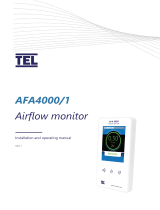
The Series AVLV Air Velocity Transmitter quickly and accurately measures air
velocity or volumetric ow in imperial or metric units. Simultaneous current and
voltage outputs on all models provide universal inputs to monitoring equipment while
the output range, units, and 0-5/10 VDC, 4-20 mA output can be congured via local
DIP switches. The optional integral display, or the portable remote tool, provide a
convenient way to locally monitor process values and congure the unit.
Models are available in 1% and 2% accuracy models and low velocity ranges to
suit a variety of needs, and the optional BACnet MS/TP or Modbus® RTU/ASCII
communication protocol allows units to be daisy-chained while providing access to all
of the velocity and ow data, as well as additional information such as air temperature.
The lower ranges in these high accuracy units allow for applications in quality intensive
environments, such as the pharmaceutical industry.
BENEFITS/FEATURES
• Minimal preventative maintenance as sensing element is covered with an engineered
protective coating
• Easy eld setup via the on board dip switches for range and units
APPLICATIONS
• VAV systems
• Building ducts
• Clean room systems
SPECIFICATIONS
Service: Clean air and non-combustible, compatible gases.
Wetted Materials: Consult factory.
Range: 100, 200, 300, 400 FPM (0.5, 1, 1.5, 2 m/s); eld selectable.
Accuracy: See chart.
Temperature Limits: 32 to 122°F (0 to 50°C).
Power Requirements: 24 VDC ±20% or 24 VAC ±20%.
Humidity Limits: 5 to 95% RH, non-condensing.
Output Signals: 4-20 mA, 0-5 VDC, 0-10 VDC.
Response Time (90%): 4 s, typical; 1 s at constant temperature.
Zero and Span Adjustments: Digital push buttons.
Output Load Resistance: Current output: 0 to 1100 Ω max.; Voltage output:
Minimum load resistance 1 kΩ.
Current Consumption: 60 mA max.
Display: 5 digit LCD (optional).
Electrical Connections: Analog: Power and output: 4-wire removable European
style terminal block for 16 to 26 AWG; Communication: Connections: BACnet MS/
TP or Modbus® RTU/ASCII: 3-wire removable European style terminal block for 16
to 26 AWG.
Supported Communication Baud Rates: 9600, 19200, 38400, 57600, 76800,
115200 (optional).
Device Load: 1/8 unit load.
Electrical Entry: 1/2˝ NPS thread; Accessory: Cable gland for 5 to 10 mm diameter
cable, A-151.
Enclosure Rating: NEMA 4X (IP66).
Mounting Orientation: Flow direction must be parallel to the sensor tip.
Weight: 6.0 oz (160 g).
Compliance: BTL, CE.
AIR VELOCITY TRANSMITTER
1% and 2% Models, Optional BACnet MS/TP or Modbus®
SERIES AVLV
1/2 NPS
2-43/64
[67.92]
3-49/64
[95.71]
[80.81]
1-19/32
[40.59]
2-5/32
[54.82]
7-41/64
[194.07]
3-33/64
[89.13]
7-17/64
[184.60]
39/64
[15.32]
Ø15/32
Modbus® is a registered trademark of Schneider Automation, Inc.
V
I
D
E
O
O
N
L
I
N
ACCURACY CHART
Velocity Range Accuracy Rating*
20 to 100 FPM (0.15 to 0.5 m/s)
20 to 200 FPM (0.15 to 1.0 m/s)
20 to 300 FPM (0.15 to 1.5 m/s)
20 to 400 FPM (0.15 to 2.0 m/s)
± (2% of reading + 0.04 m/s [7.9 FPM])
± (1% of reading + 0.04 m/s [7.9 FPM])
± (2% of reading + 0.04 m/s [7.9 FPM])
± (1% of reading + 0.04 m/s [7.9 FPM])
± (2% of reading + 0.05 m/s [9.8 FPM])
± (1% of reading + 0.05 m/s [9.8 FPM])
± (2% of reading + 0.06 m/s [11.8 FPM])
± (1% of reading + 0.06 m/s [11.8 FPM])
*Accuracy dependent on model selected when ordering.
217
Air Velocity Transmitters
AIR QUALITY
DWYER INSTRUMENTS, LLC | dwyer-inst.com
MODEL CHART
Example AVLV -2 D A1 -LCD AVLV-2DA1-LCD
Model AVLV Air velocity transmitter
Accuracy 2
1
± (2% of reading + 0.06 m/s)
± (1% of reading + 0.06 m/s)
Mounting D Duct mount
Output A1
B1
M1
Analog universal (0-5 VDC, 0-10 VDC, 4-20 mA)
Analog + BACnet MS/TP
Analog + Modbus® RTU/ASCII
Options FC
GLD
LCD
NIST
Factory calibration certicate
Electrical cable gland
LCD display
NIST certicate



